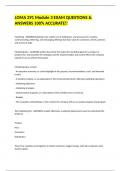LOMA 291 Module 3 EXAM QUESTIONS &
ANSWERS 100% ACCURATE!!
Marketing - ANSWERMarketing is the activity, set of institutions, and processes for creating,
communicating, delivering, and exchanging offerings that have value for customers, clients, partners,
and society at large.
Marketing plan - ANSWERA written document that states the marketing goals for a product or
product line, and describes the strategies and the implementation and control efforts the company
intends to use to achieve those goals.
Marketing plans contain:
- An executive summary, or a brief highlight of the purpose, recommendations, costs, and intended
results
- A situation analysis, or an explanation of the environmental factors affecting marketing operations
- Marketing objectives
- Marketing strategies
- Tactical/action programs, or a description of the activities to be carried out
- Budgets
- The evaluation methodology, or the controls the company will use to analyze progress toward goals
The Marketing Mix - ANSWERTo market effectively, marketing departments need to understand the
details of
Product
Price
Promotion
Distribution
These four variables work together to attract customers, trigger buying, and help companies meet
business goals.
,Product - ANSWERThe goods, services, or ideas that a seller offers to customers to satisfy a need.
Some specialization possibilities for insurance - ANSWERUnder life Insurance are term life, whole life,
group life, universal life, variable universal life, indexed universal life, and final expense insurance.
Under medical are group major medical, individual major medical, and supplemental medical. Under
disability are short-term disability, long-term disability, and long-term care.
or
Under annuities are qualified annuities, nonqualified annuities, fixed annuities, variable annuities,
indexed annuities, immediate annuities, and longevity insurance. Under retirement are 401(k),
401(b), and pension plans. Under voluntary benefits are dental insurance, vision insurance, and
critical illness insurance.
Product Mix - ANSWERThe assortment of products a company offers.
Financial design - ANSWERThe combination of all the financial features of a product.
Which of these do you think are potential features of insurance product financial design? Choose all
that apply.
Required premium payments
Mortality charges
Charges for features, benefits, guarantees, etc.
Fees for services, transactions, etc.
Charges (if any) for early surrender or withdrawal
How fast the cash value accumulates
Investment or interest rate minimum guarantees
Guaranteed income, accumulation, or withdrawal benefits - ANSWERAll of them
distribution - ANSWERThe collection of activities and resources involved in making products available
for customers to buy.
Face to face meeting methods - ANSWERCareer agents
,PPGAs
Independent agents
Broker/dealers
Registered investment advisors (RIAs)
Banks and other depository institutions
Other insurance companies
Employee benefits brokers
direct to consumer methods - ANSWEREmail
Company website
Phone
Mail
Promotion - ANSWERThe collection of activities that companies use to make customers aware of
their offerings and to influence customers to purchase, and distributors to sell, a product.
3 types of promotion:
- personal selling
- advertising
- publicity
personal selling - ANSWERconversation between a sales agent and one or more prospective
customers, either face to face or over the phone. Insurers use personal selling extensively, because it
is an effective way to convey information about a complex product.
he customer can ask questions to clarify information
The financial professional can customize the message to fit the situation
Advertising - ANSWERAny paid form of nonpersonal communication or promotion about a company
or its products or services that an identified sponsor generates and transmits through any type of
media
, Institutional advertising - ANSWERAdvertising that seeks to promote a general image of the company
rather than to explain a specific product. Also known as image advertising.
product advertising - ANSWERAny advertising used to promote a specific product or service.
publicity - ANSWERAny form of nonpaid communication about a person, place, thing, or cause.
Another marketing mix model: The four C's - ANSWERCustomer: The insurer analyzes who its
customers are, what their needs are, and what products it can provide to meet those needs.
Cost: The insurer examines the value of its product for customers and the appropriate price to ask,
given the alternative products available from competitors.
Convenience: The insurer ensures that customers can learn about and purchase its products in the
ways that best meet their needs and preferences.
Communication: The insurer communicates with its customers over multiple channels to create an
ongoing relationship that will promote customer loyalty.
Marketing Mix Objectives - ANSWER- Fit together so that each one supports the others: The type of
product a company offers determines the type of distribution methods the insurer uses. The type of
distribution an insurer chooses for a product, in turn, helps determine the product's price.
- Align with the company's overall strategic goals: If a company's strategic goal is to be an industry
leader in sales of term life insurance, the marketing mix should include specific strategies for
customer, cost, convenience, and communication that will allow the company to sell term life
insurance policies to customers more successfully than its competitors can.
- support the company's positioning strategy: Through positioning, an insurer attempts to distinguish
itself from other insurers in the marketplace by building a company image or product image that
contrasts with the images competitors offer. An insurer may position itself on the basis of company
or product attributes, types of products offered, price and quality of products, markets serviced, or
distribution characteristics.
- Support the company's branding strategy: Companies develop branding strategies to distinguish
themselves among competitors. A company's brand—such as its name, slogan, and visual elements
like a logo or color scheme—can draw customers to that company. To develop brand loyalty among
customers, insurers need to create positive reactions to the brand by delivering positive customer
experiences.




